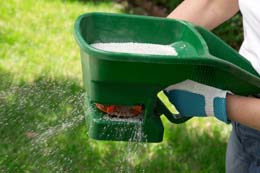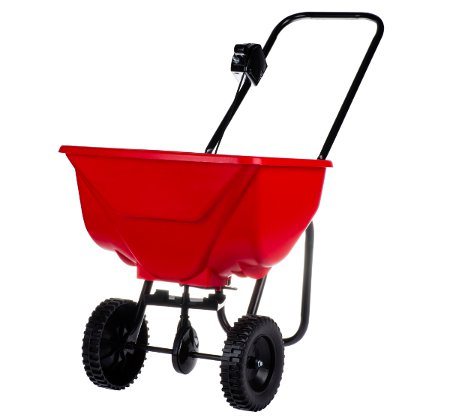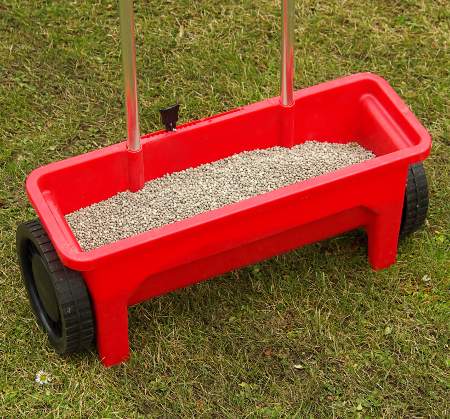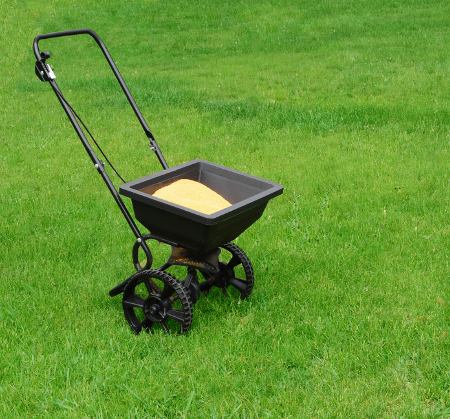Lawn fertilizer spreaders are tools that are used for the uniform distribution of fertilizers over a lawn. These machines are available in different types and forms. Some of the commonly used ones are discussed in this article.

Fertilizer spreaders are widely used by lawn owners. These devices prevent the formation of fertilizer clumps during their application. This is because the manner in which the fertilizers are spread, holds importance from the point of view of the proper lawn growth.
Types
The difference between the following types is based on factors such as the area of the lawn and the method of application.
Press F5 to restart the slideshow.

- Broadcast Spreader

- Drop Spreader

- Top Behind Broadcast Spreader

 Broadcast Spreaders
Broadcast Spreaders
It is used for lawns spread over a large area. The machine is also known as the rotatory spreader, due to the disc that it employs. This disc helps in spreading the fertilizer with the help of its spinning motion. During the process of fertilizer distribution, the matter falls on the disc, and is then dispersed evenly across the lawn. One can also control the amount of fertilizer that is spread through this spreader.
Drop Spreaders
They are more accurate in their distribution of fertilizers, as compared to broadcast ones. These are used for lawns that have a small area, generally less than 5,000 sq. feet. The container that holds the fertilizer resembles a bucket, and has wheels that enables to move it around easily. One of the advantages of this device is that they can be used in tight corners, or in similar awkward positions of the lawn. These are inexpensive as compared to the other types. Unlike the broadcast ones, there is no wastage of fertilizers while using the drop spreaders.
Centrifugal Spreaders
They are similar to the drop spreaders, except for the fact that the area covered by the former ones is greater. The path in which the machine distributes fertilizers is wider, as compared to the drop spreader, and is 8 inches in width. These machines are thus considered to be better than the previously mentioned one. However, while spreading fertilizers, it becomes difficult to keep them steady. Many centrifugal spreaders are available with an installed deflector. This makes it easy for the fertilizers to be applied along flowerbeds and sidewalks.
Aerator Spreader
The aerator spreader is a tool that combines the functionality of both the lawn spreader and the aerator. This machine possesses tines, which help it to penetrate the soil surface up to a depth of 2 inches, which is the right depth for placing nutrients. Since the fertilizer is applied in a 40 inch wide path by means of this device, it is possible to cover a large area. Assembling the aerator spreader though is quite a tedious job. Its fertilizer holding capacity is around 100 lbs, and hence, it can be used for big lawns.
Top Behind Broadcast Spreader
This gadget can hold up to 80 lbs. of fertilizers, and is attached behind lawn tractors. The spreaders have a mechanism that helps to control the rate of application. The width of the path in which the fertilizers are applied is 10-12 feet. It enables the machine to cover an area of 25,000 sq. feet in one go. Thus, it is possible to overcome the problem of frequently reloading the spreader.
Calibration and Use of Lawn Spreaders
It is an important step in the process of using these machines. Directions for the calibration can be obtained from a nearby garden center. Although lawn spreaders are usually calibrated by the manufacturer, it is necessary to adjust every machine to the conditions, in which it has to be used.
While using a lawn fertilizer, the peripheral area should be covered in the beginning itself. The internal area should be fertilized by moving the spreader back and forth. This procedure helps to properly cover the entire area. Care should be taken to use the fertilizers that are safe, and won't cause any harm even if consumed by pets.
If the above mentioned steps and procedures are followed properly, these spreaders provide excellent results.






 Fertilizer spreaders are widely used by lawn owners. These devices prevent the formation of fertilizer clumps during their application. This is because the manner in which the fertilizers are spread, holds importance from the point of view of the proper lawn growth.
Fertilizer spreaders are widely used by lawn owners. These devices prevent the formation of fertilizer clumps during their application. This is because the manner in which the fertilizers are spread, holds importance from the point of view of the proper lawn growth.



